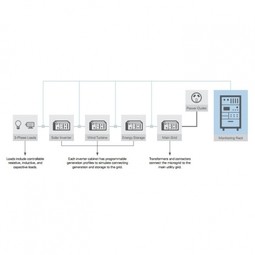Overview
 |
Microgrid |
Applicable Industries
Applicable Functions
Case Studies
Market Size
|
The microgrid market is expected to grow from USD 19.22 billion in 2017 to USD 39.10 billion by 2023, at a CAGR of 11.97% during the forecast period. Source: Markets and Markets The global microgrid market is expected to reach USD 17.51 billion by 2025,growing at a CAGR of 17.0% Source: Grand View Research
|
Business Viewpoint
|
What is the business value of Microgrids? - It improves electric reliability: microgrids keep the power flowing by disconnecting (or islanding) from the central grid when it begins to fail. The microgrid’s generators, and possibly batteries, then serve the microgrid’s customers until power is restored on the central grid. - It enhances resilience/recovery: it immediately restores power to an entire building or operation, leaving occupants barely aware a disturbance occurred. It also is programmed to restore only critical services within a facility. - A microgrid can lower energy costs for consumers and businesses: it reduces costs through the efficient management of energy supply. Microgrids can earn revenue by providing ancillary services to the central grid. Ancillary services provide support functions for the grid, such as frequency control and spinning reserve. - It improves the environment and promotes clean energy: microgrids can employ a wide range of green power production technologies. These include solar, wind, fuel cells, combined heat, and power (CHP) plants, and energy storage technologies. Natural gas generators, used in many CHP plants, fall on the cleaner side of fossil fuels. What are its benefits even those outside its footprint? - A microgrid strengthens the central grid - It bolsters cybersecurity - It brings economic value to society - It improves community well-being
|
Stakeholder Viewpoint
|
Who is the target audience?
|
Technology Viewpoint
|
What types of technologies are used within a smart microgrid at home? Smart meters allow for the two-way exchange of pricing, usage data, and electricity. Programmable smart appliances and devices that come on when the price of power reaches the consumer’s desired price point. User-friendly home energy control systems that allow customers to interface with the smart microgrid to automatically control every aspect of a home’s power usage. Energy efficiency improvements that help consumers use less energy and ultimately save money on monthly electricity bills. What types of technologies are used within a smart microgrid at work? Advanced energy control systems to make commercial buildings “smart.” Advanced lighting technology with digitally programmable controls that are responsive to the cost of power, the number of occupants in a building and where occupants are located. New heating and air conditioning technology that automatically adjusts building ventilation rates in real time based on occupancy, air quality, the cost of power or any other factors a manager chooses. New electricity generation systems that can provide power to individual buildings and supply power to the entire grid. And within the electricity distribution system? “Smart” switches, relays and sensors that replace their outdated and inefficient predecessors to allow the smart microgrid to manage and distribute power more efficiently and reliably. Redundant designs that provide a second source of power when recurring storms, ice and squirrels interrupt power. Protected infrastructure installed underground or within structures. Computerized controls that constantly scan for, and even anticipate, potential instabilities to correct problems before users experience any disruption in service.
|
Data Viewpoint
|
Energy Monitoring: Microgrids collect data on energy generation, consumption, and storage to provide insights into energy usage patterns, demand forecasts, and system performance. This data helps operators optimize energy distribution, minimize waste, and improve overall system efficiency. Grid Integration: Data from microgrids can be integrated with grid management systems to facilitate two-way communication between microgrids and the main grid. This allows for dynamic grid balancing, demand response, and efficient energy trading between microgrids and the broader energy market. |
Deployment Challenges
|
What are the challenges of Microgrids in the electricity system? - Voltage and frequency control: active and reactive power generated has to be in balanced condition with the power consumed by the loads including the losses in the lines. In operation of the microgrid, a challenging task is to operate more than one distributed generation on the island; it is no possible to use the active and reactive power control. It is necessary to regulate the voltage during microgrid operation by using a voltage versus reactive power droop controller for local reliability and stability. - Islanding: it is a small-scale representation of the future interconnected grid with a high density of distributed generations. The microgrid provides a benchmark between island and the interconeected grid. It is can be used in the large interconnected grid with the high penetration of distributed generation. The islanding control strategies are very important for the operation of a microgrid in autonomous mode. - Protection: once a microgrid is formed, it is important to assure the loads, lines and the distributed generations on the island are protected. The two alternative current limiting algorithms to prevent the flow of large line currents and protection of microgrid during utility-voltage sags. There are as resistance-inductance feedforward and flux- charge-model feedback algorithms, for use with a voltage- source inverter (VSI) connected in series between the micro source and utility grids.
|




